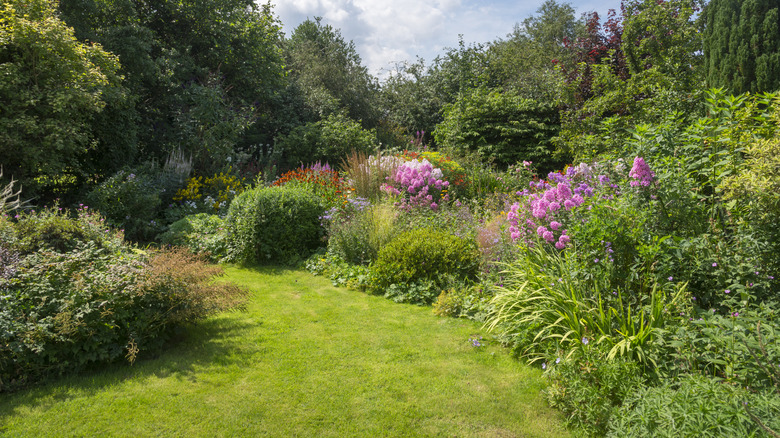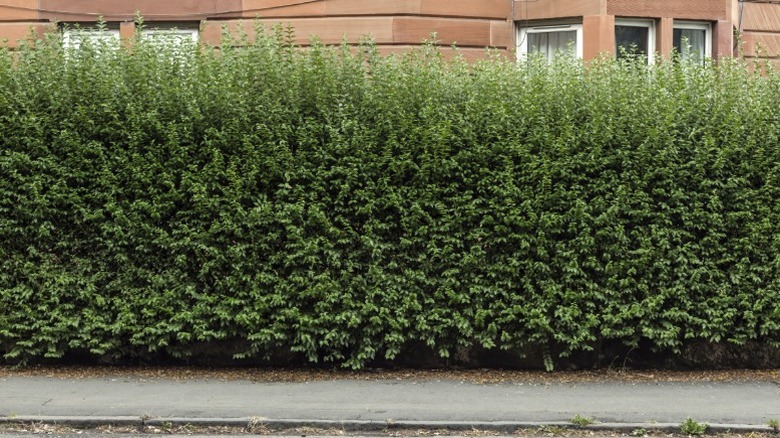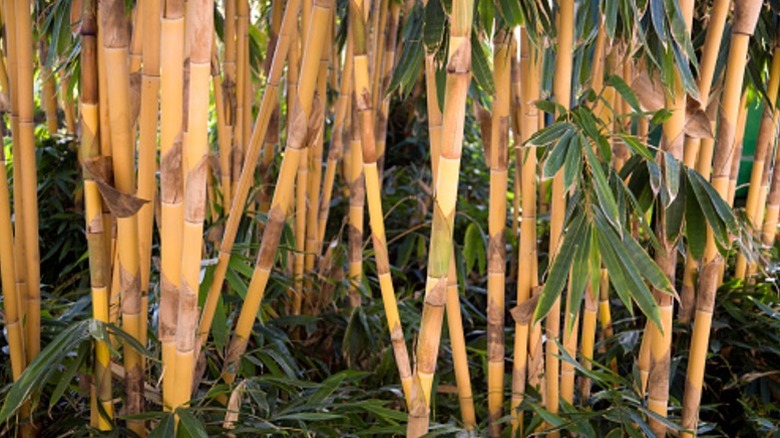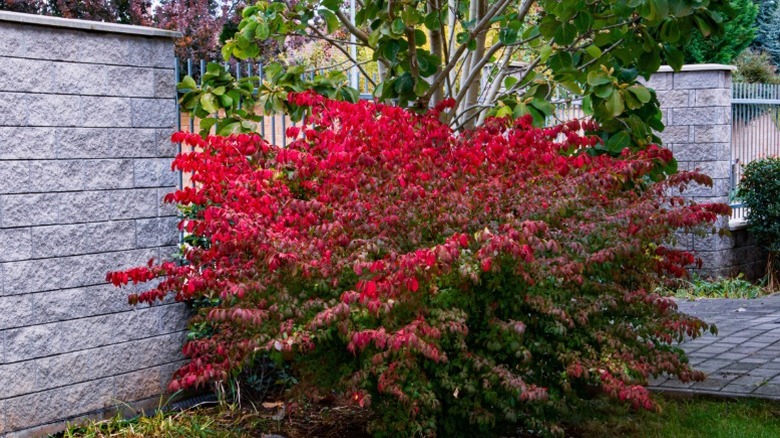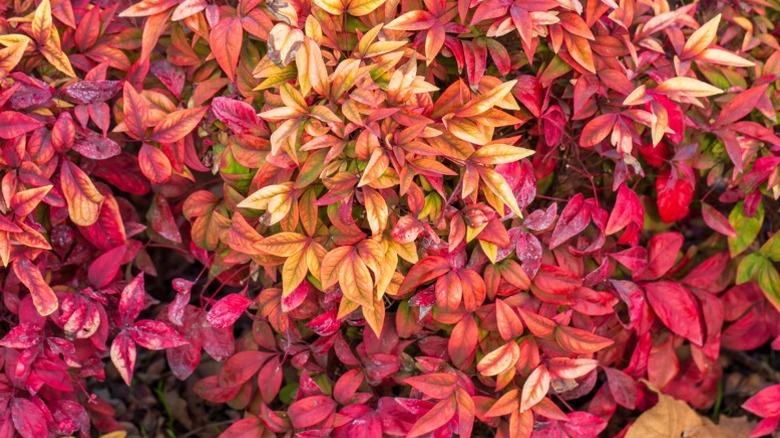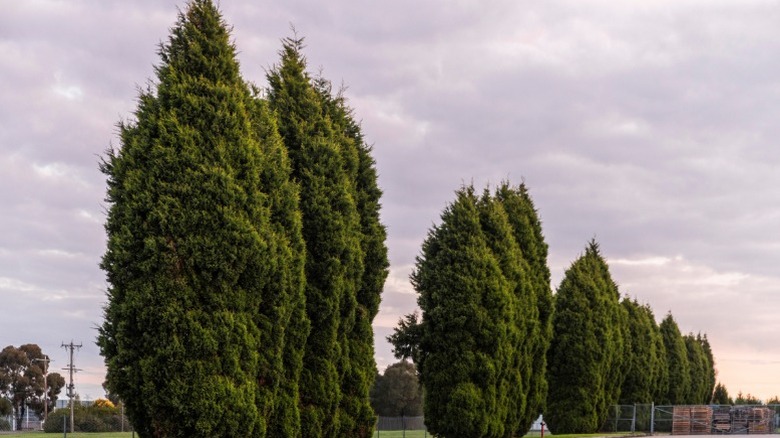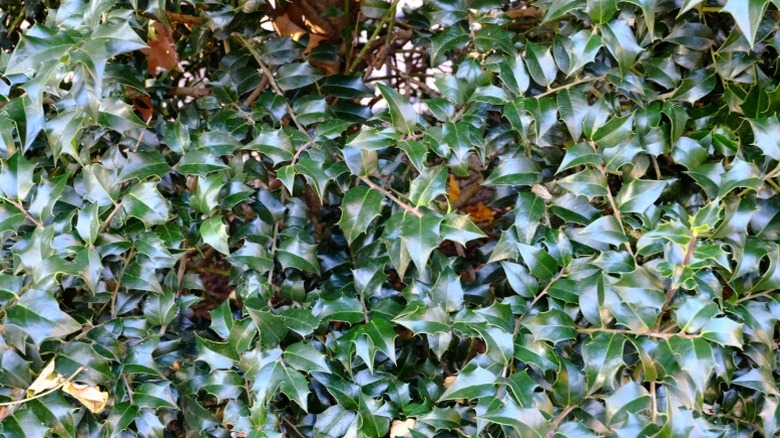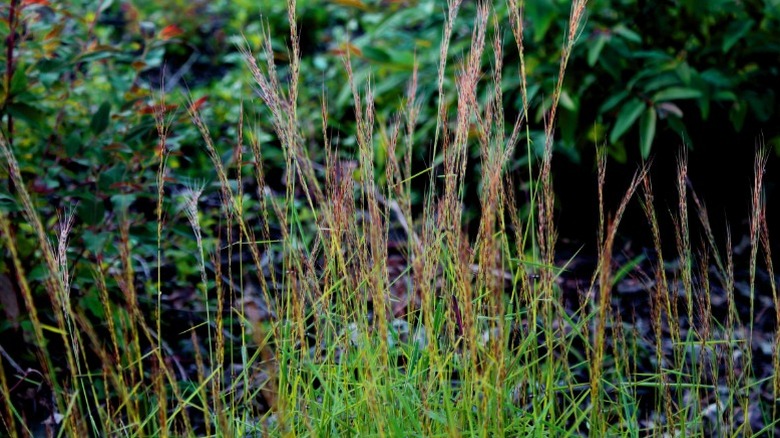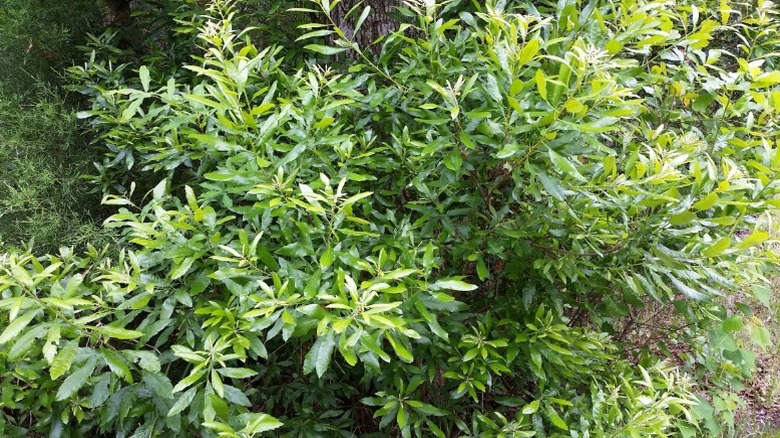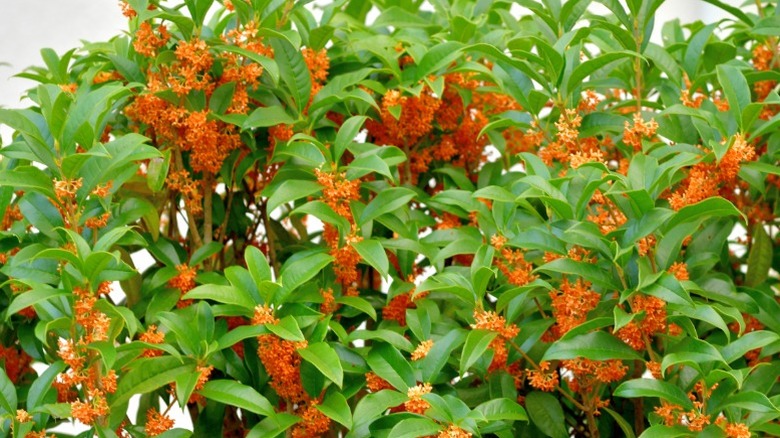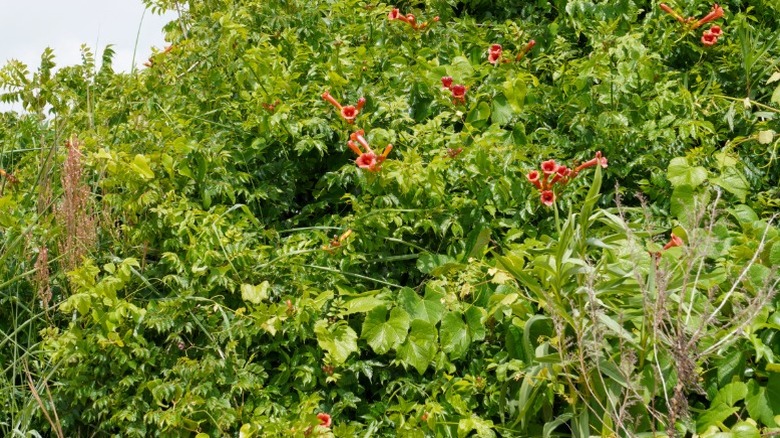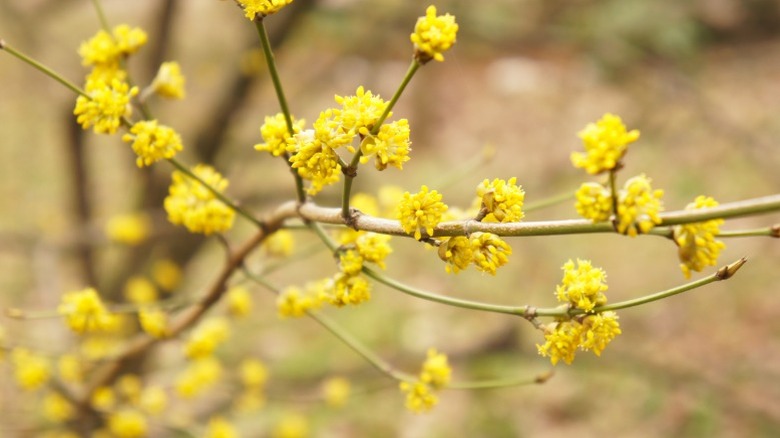8 Fast-Spreading Invasive Privacy Plants To Avoid (And What To Plant Instead)
When looking for plants to grow as living privacy screens, you might have quick-growth options fairly high on your list of must-haves. But when it comes to shrubs, trees, and ornamental grasses, you don't want to grow species that spread too quickly or overtake your lawn. Many popular privacy plants are actually invasive species that cause more headaches than good. While you might enjoy the look of European privet (Ligustrum vulgare) or the fast-growing coverage of certain bamboo species, like golden bamboo (Phyllostachys aurea), these are examples of species you should avoid planting in your yard.
Instead of planting invasive species that can overtake your yard and the surrounding area, plant species like American holly (Llex opaca), sweet olive (Osmanthus fragrans), and wax myrtle (Myrica cerifera). Compared to fast-growing plants that can be tough to control, these are plants to consider when looking to add privacy to your yard that won't overtake it. Native or non-invasive non-native privacy plants are ideal, because they benefit local wildlife and grow well in local conditions.
Avoid Privet
From European privetto Chinese privet (Ligustrum sinense), most privet species brought to the U.S. are now considered invasive. For example, European privet, also known as primwort, is a popular hedge shrub that grows very quickly and is listed as invasive in several states. Not only does privet exhibit a fast growth rate, it also notoriously spreads beyond yards from birds eating seeds. To recognize invasive privets, look for simple leaves with opposite arrangements and stems with grayish bark. Not all species are invasive, but it's best to avoid them for privacy hedges if you're not sure.
Don't plant golden bamboo
Some varieties of bamboo that are not invasive, but it's best to avoid golden bamboo for privacy screens due to its quick growth. Described as running bamboo due to spreading via rhizomes, these plants are difficult to contain. Today, it is classified as invasive across several states, including Maryland, Pennsylvania, and Georgia. Golden bamboo grows between 10 and 20 feet tall. Identify it by the short swollen internodes bunched at the base of some canes and the fan-shaped green leaves. Luckily, there are plenty of better alternatives for invasive golden bamboo.
Stay away from Buckthorn
Homeowners who want a dense hedge may consider using common buckthorn (Rhamnus cathartica) or glossy buckthorn (Rhamnus frangula), which were brought from Eurasia in the 1700s. These small trees don't actually grow thorns and have attractive foliage, which are both reasons they're sometimes used as privacy plants. However, both of these species of buckthorn are invasive, spreading their incredibly dense growth into wildlife areas beyond home landscaping thanks to birds eating its little purple-black berries. Growing up to 25 feet tall, it can outcompete native plants by preventing sunlight. It also might put out chemicals that prevent plants from thriving.
Beware of burning bush
The bright, brilliant red of burning bush (Euonymus alatus) has been used a lot for its ornamental value in the U.S., but it's actually a native to Asia. Burning bush can grow up to 20 feet tall and features green flowers in spring and bright red leaves in fall. While you might favor this species for hedges or other privacy barriers to capitalize on its fall color, it's difficult to contain it due to its ability to spread unchecked beyond your landscaped lawn. This invasive species will outcompete native plants and is prohibited in some states.
Keep Japanese barberry away
A dense shrub with many small branches, Japanese barberry (Berberis thunbergii), was first introduced to the U.S. in the late 1880s. Although used widely as living privacy screens to take advantage of its deer-resistant qualities, this shrub very easily spreads as birds and animals eat its fruit. It also has a tendency to set down roots in places where its branches meet the ground. You should avoid growing Japanese barberry in your yard for privacy due to its dangerous connection with the black-legged tick. Notably, research has found more ticks in spaces densely populated with barberry shrubs.
Don't plant sacred bamboo
Another native of Asia, sacred bamboo (Nandina domestica), is an evergreen shrub. It has attractive white flowers in spring, red berries in autumn, and fern-like foliage. Often referred to simply as nandina, this plant is popular as a privacy plant in the southern U.S. because it is both drought resistant. But nandina can spread outside of home gardens via birds and other wildlife. You'll also want to avoid planting it due to the toxic compounds (cyanide) in its fruit, which are extremely dangerous for humans and animals, including cats and dogs.
Avoid leyland cypress
Leyland cypress (Cuprocyparis leylandii) is a hybrid evergreen tree with scale-like leaves. These trees are incredibly popular among landscapers for their quick growth rates. Although this plant is not traditionally considered invasive, being a sterile hybrid of two species, it has aggressive tendencies that you might want to avoid. A big issue with this tree is that it can grow much larger than you initially expect, taking up a larger space in your yard than planned. These trees also can easily be affected by root rot, which can quickly spread.
Keep Chinese silvergrass away
Chinese silvergrass (Miscanthus sinensis), also known as maidengrass, is a very common ornamental grass variety grown to provide privacy in landscapes across the U.S. A highlight for landscapers is the way that the plant remain standing even after dying prior to the dormant season. It's also popular due to its low maintenance and deer resistance. However, Chinese silvergrass is not native to the U.S. and was brought over from Asia. This invasive grass spreads when the seeds are picked up and blown away by the wind, and is considered highly flammable. Individual plants grow via rhizomes and can pop up elsewhere in the landscape unexpectedly.
Plant American holly
Instead of planting something invasive, consider a native holly tree, like the American holly, that also features red berries, which provide food for wildlife. Although American holly has a slow growth rate, this evergreen tree is ideal as a privacy screen with its symmetrical canopy shape. Although it doesn't do well in smaller yards, when given the space to grow, American holly can reach 35 to 50 feet tall, with a 15 to 25 foot spread. A broadleaf species, female plants provide both beautiful color and fragrance to your yard. American holly is hardy from Zones 5 to 9.
Consider yellow indiangrass
Instead of invasive Chinese silvergrass, opt for a native, wildlife-friendly alternative like yellow indiangrass (Sorghastrum nutans). This ornamental grass reaches heights of 3 to 8 feet, making it a good choice to plant as a privacy barrier in your yard. Highly resistant to various environmental concerns, like deer, drought, and air pollution, this grass can provide year-round interest and cover. It is a clumping grass that has potential to spread, but is not invasive. Note that this grass, hardy from zones 4 through 9, is considered flammable and should never be planted too close to a dwelling.
Take a look at wax myrtle
A broadleaf evergreen species native to the U.S., wax myrtle is a popular option for privacy barriers thanks to its tolerance of urban conditions like salt and limited root space. Also known as southern bayberry, this shrub is capable of reaching a mature height of 15 to 20 feet tall. Birds also enjoy the waxy, sweet-smelling fruit that grows in the fall. The fragrant flowers of the wax myrtle are another reason to choose it as a privacy plant. It's capable of growing 5 feet over the course of one season.
Give sweet olive a try
Although many gardeners prune sweet olive into small ornamental trees, this evergreen shrub can reach heights between 5 and 20 feet and widths between 7 and 20 feet. A dense-growing shrub, sweet olive is native to Asia, but not invasive and is hardy from zones 7 to 9. Also called tea olive, this species takes well to pruning, which means it is great for hedges. It prefers soil with good drainage, but tolerates heavy clay or sand. The subtlety of this plant along with its upright growth, makes it a good option for a privacy hedge.
You might enjoy coral honeysuckle
Instead of invasive vines, train coral honeysuckle (Lonicera sempervirens) to climb up fencing to create a living privacy hedge. A semi-evergreen vine, coral honeysuckle can grow between 8 to 15 feet long. It features lovely red flowers attractive to pollinators, making it a flowering vine that will keep hummingbirds coming back to your yard. Compared to other types of vines, this species is not as aggressive, but will still provide ideal cover. Originally native to the southeastern U.S., it is hardy from Zones 4 through 9, and has naturalized in more eastern areas without becoming a problem.
Plant spicebush
If you're looking for a native alternative to forsythia, consider spicebush (Lindera benzoin), a beautiful deciduous shrub native to central and eastern U.S. It grows very tall and wide, with dense growth in full sun or more spread out in shaded areas. It is a popular choice to grow as a border plant thanks to its tendency to grow into a broad, rounded shape. Spicebush is low maintenance and doubles as an important species for pollinators and various species of birds, who eat its bright red berries. This shrub can be grown in hardiness zones 5 through 9.
